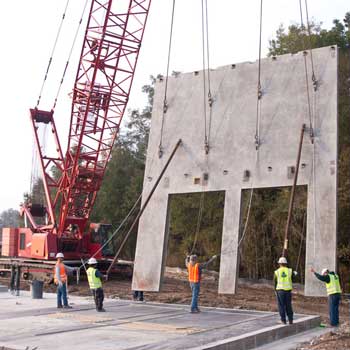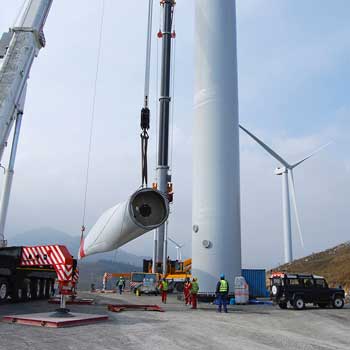When the United Nations launched their Decade of Action campaign early this year, eight out of its 17 goals were tied to sustainability and protecting the planet. These goals reflect the global trend of companies moving toward more sustainable initiatives in an effort to reduce negative impacts on the environment.
One of the industries leading the charge on sustainability is construction. By utilizing environmentally friendly practices in projects and installing renewable energy sources across the world, construction is helping people move to a greener lifestyle.
Prefabrication is the process in construction where building components are pre-assembled offsite and then transported to the project where they are put in place. With this process, the offsite assembly allows for more sustainable practices as they recycle and reuse excess materials.
Additionally, prefabrication allows more a more accurate build and construction of building components and units. With a team solely focused on building these pieces, the accuracy and quality of the work increases while the waste produced decreases.
In addition to a reduction in waste, prefabrication also requires less energy as heavy machinery and equipment remains in the same offsite assembly area. Constantly moving this equipment to assemble pieces in traditional methods of construction requires a significant amount of fuel.
Overall, as offsite prefabrication techniques have become more popular, there are well documented benefits like greater control of quality, faster construction phases, less waste and increased sustainability.

Practicing sustainable construction is not just about reducing waste and energy costs while in the building phase of a project. While this is a key part, it is equally important to create a building that maximizes energy and water efficiency while utilizing natural light and reducing energy costs at any point possible.
This ensures the continued practice of sustainability for the entire future of that building’s use. These builds, therefore, ensure that the future tenants of that building will be practicing sustainable habits – even if they don’t realize it.
The current industry standard for sustainable construction is the LEED certification. This certification is available for nearly all building projects and “provides a framework for healthy, highly efficient and cost-saving green buildings.”
Among the benefits identified by LEED, certified buildings from 2015 to 2018 experienced $1.2 billion in energy savings, $149.5 million in water savings and $715.3 million in maintenance savings – just to name a few of its perks.
The trend toward sustainable and efficient projects not only reduces the carbon footprint of construction, it ensures an environmentally friendly life for the tenants of that new building.
Over the last four decades, solar panel installation has become increasingly popular and is a common source of renewable energy. And solar has become more affordable: the price has fallen over 99% in 40 years!
This dramatic decrease in price is the result of increased technological innovation and government policies that were created to grow markets and fund solar panel installations. Since its rise in popularity over 40 years ago, there are now nearly 250,000 Americans working in the solar industry, including the rise of the solar photovoltaic installer career path.
Among its technological innovations, the panels have continued to improve efficiency in the amount of energy converted from sunlight. These increases in efficiency have made the panels all the more effective and a popular choice for renewable energy.
The growing use of solar panels has contributed to a reduction in the use of nonrenewable resources, which prevents pollution and promotes sustainability. Disney recently installed a solar panel facility on 270 acres of land that will reduce 50,000 tons of greenhouse gas emissions every year. This large-scale project is just one of the ventures into solar installation that is having a huge impact on sustainability today.
Similar to solar panel installation, wind power technologies have risen in prominence as a way to harness energy in a renewable way. Technological innovations and reductions in the cost of installation have brought wind energy to the third largest source of US energy generation in 2018, behind solar energy and natural gas.

The wind turbine industry has also experienced 69% decrease in costs since 2009 as a result of technological advances and a rise in wind turbine technicians. As of 2019, there were over 114,000 Americans working in the wind energy industry and there were more than 57,000 turbines generating electricity across the country.
Using renewable resources to generate energy helps push the country to a more sustainable status. As of 2018, electricity generated from wind turbines avoided almost 200 tons of carbon pollution from entering the atmosphere – a huge win for the environment.
Overall, as the world moves toward practicing more sustainable habits and technologies, the construction industry is helping to contribute to the greener world. With several construction careers aligning with an environmental focus, this trend will only become more widespread and common.